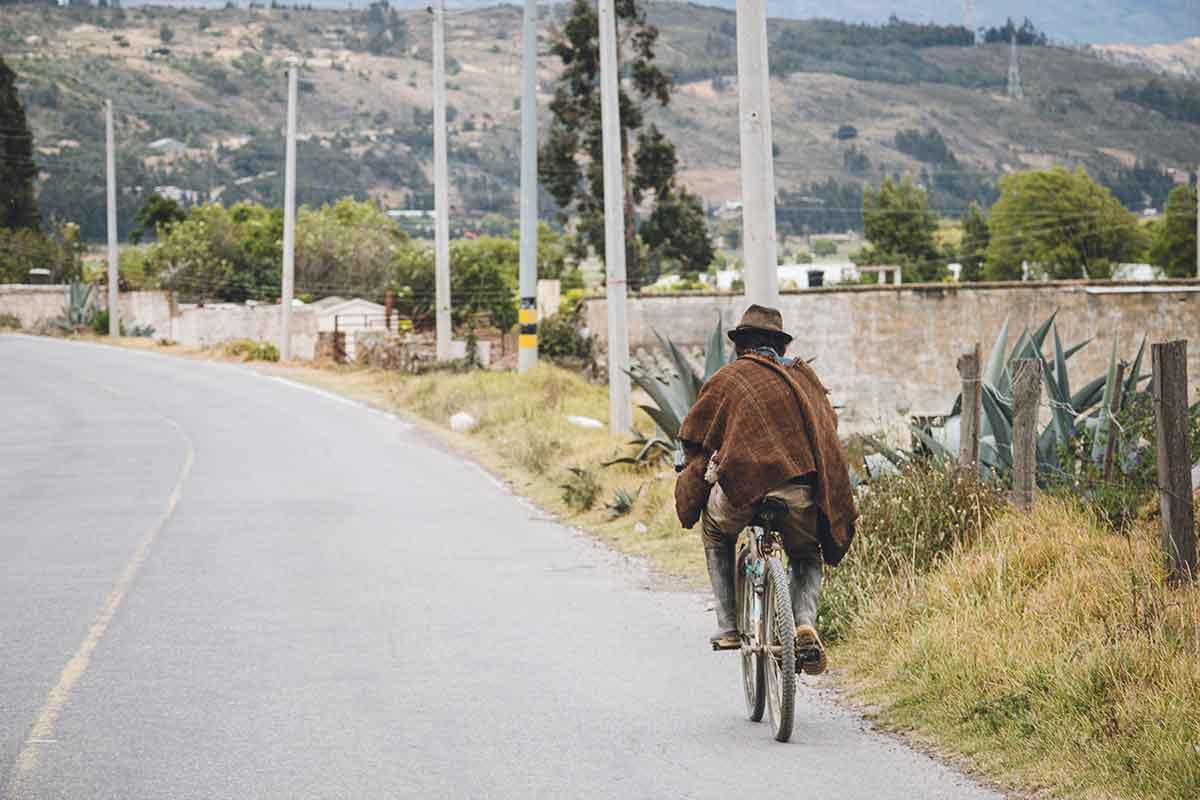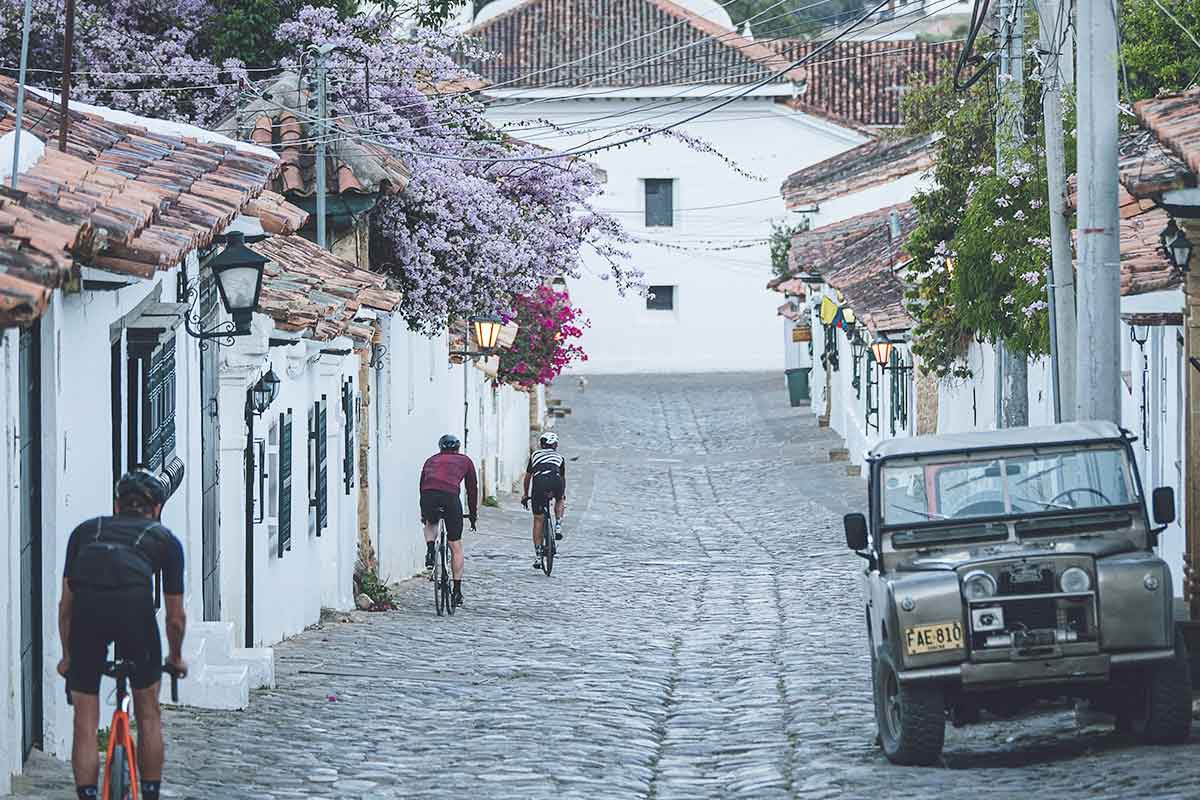Bogota and its Surroundings: Mecca of American Cycling
A new history of the country is written in pieces. Besides the world cycling stars that have trained in the rugged national geography, a rich local culture revolves around these ‘steel horses’. Bogota’s strategic location makes it an ideal cycling destination to conquer the mountains of its neighboring towns.
Cyclists arrive with their bicycles; they travel as members of an ancient and viral cult, always determined to reach a new summit, and share their passion with a colleague. With the cyclists comes everything else: the appetite that must be satisfied after a hard ride; the need for a spare or a new garment; or the simple whim of taking something home.
Cyclists are passionate and gregarious ambassadors who spread their inspiration wherever they go. They are—we are—an international lodge, almost always silent and benign, that conquers and transforms territories.
Bogota is the beating heart of a nervous system whose fluid is made up of diverse riders. From that center, irrigated through countless arteries, the sap travels to various points in search of more and more land to cover. We, the cyclists of the capital city, begin our trips within its borders, along the most extensive infrastructure of the continent: 500 kilometers of exclusive roads. But cycling is a constant craving, which every week drives us to go further and further.
You may also be interested: Biking through Los Nevados Park.
The First Routes
By 2024, the bicycle business around the world, which includes vehicles, clothing and accessories, will reach a total of USD 62 billion. The United States and Italy are the main bastions of this global industry, but Colombia has the fastest growing industry in Latin America. The bicycle is part of our national spirit.
From 1951, with the first Tour of Colombia by bicycle, the races drew the map of a country that was still unknown to its own inhabitants. Over the years, attracted by that deed, many foreigners also wanted to travel the vast Colombian geography by bicycle.
In Bogota, the capital city, about one million cyclists go out to the streets every day and move around the city. On Sundays, when the main avenues are closed, the number grows by a considerable number: more than ten percent of the total population goes out to cycle the roads.
The primary pathways of the cyclist’s nervous system are in the avenues of Bogota, where workshops for bicycles, cycling clothing sales, cycling shops of various sizes and much more are progressing and multiplying. This whole system emerged and has evolved as a result of the cycling phenomenon; it is a human and economic ecosystem that would not exist without the bicycle. But its logic has grown so much that it now goes beyond the capital.
Did you know that Colombian geography allows cyclists to ascend to more than 3,000 MASL, even in routes for beginners?
The Alto de Patios is the oldest and most obvious example of this process: a key point of the conquest on two wheels. Patios used to be just a stopover on the road that leads from Bogota to the town of La Calera; with a fuel station, a toll and a few street food vendors. But the seven-kilometer ascent became a training area for amateur cyclists: a series of quiet, easy and sometimes tight curves, which take a good half an hour to summit, and are visited by at least five thousand cyclists every Sunday. At least five thousand cyclists complete this tour. Upon arrival, a wide range of options opens before the eyes of the struggling exhausted cyclist.
Patios offers at least thirty stores where you can get a great breakfast: eggs with arepa stuffed with cheese from Boyaca, freshly-baked pandebonos and almojabanas, empanadas, bagels, sandwiches, cakes, juices, sodas, energy drinks and, above all, agua de panela, the Colombian drink par excellence; the same that the first Colombian cyclists who participated in the Tour de France drank. Every Sunday, the Alto de Patios becomes a festival that lasts several hours, from early in the morning until well into midday. Hundreds of direct and indirect jobs are created, and dozens of families benefit from this activity.


In these towns the bicycle culture involves everyone equally: children, farmers, training athletes and professionals share these routes.

Towards More Difficult Routes
Through the Cerros Orientales, along the road to La Calera, cyclists can access different routes. Many choose to climb the Alto de las Arepas, where they stop for breakfast before riding back to Bogota. There are about 50 kilometers round trip, from the International Center, the geographical and economic heart of the capital.
Others, more ambitious and stronger, continue straight to an area called El Cruce, where there is another corner with places where you can have delicious empanadas, eggs, traditional soups, or different kinds of delicious baked goods bakery before undertaking the way back. There are more options from El Cruce: go to Sopo and Briceño, two northern towns in the middle of the savanna, and return on the highway to Bogota. Or choose the hard way back along the same path.
The huge amount of visitors to El Cruce, show how cycling, a democratic sport, gathers and mixes all social classes. You can see mostly men, around their forties and fifties, wearing the finest clothes (international brands that cost several hundred dollars), 80s uniforms that advertise hardware stores and neighborhood pharmacies, or even informal teams sponsored by themselves.
Cycling has become a meeting point for people of all economic strata, and the road makes them equal. Friends and colleagues get together to do sport, to relax; but also to do business that will be good for everyone. That’s why it is called ‘the new golf ’: the event where important business alliances take place. But something relevant changes when you go from the clubs and the holes to the pedals: your stage is no longer a huge and private field. Here, the court is the endless route; the road, which we all share in a less exclusive and more egalitarian ceremony.
From El Cruce, to the northeast, a high road leads first to the town of Guasca, and then towards Alto de La Cuchilla, one of the most demanding ascents in the area, very close to the Tomine reservoir. From the city, round trip, there are about 130 kilometers, with more than 2,500 meters of total height difference along the ride.
La Cuchilla, in terms of infrastructure and alternatives for those who manage to get there, is the starting point of almost all cycling enclaves: a lonely wasteland. The first person who offers something is a young man who gets up there on his uncle’s motorcycle with a small basket full of sweets and two red thermos bottles with coffee, nothing else.
Recently, two or three minimalist entrepreneurs have joined the boy, and they set up their tables and sell juices for the exhausted riders. At the top of the mountain, cyclists are welcomed only by these people under a blue billboard where Nairo Quintana, the “beetle”, most successful cyclist in the history of Colombian cycling, raises his arms under a phrase that says: “I reached the Alto de La Cuchilla”.
You may also be interested: Colombia in numbers.
The Craziest, the Most Beautiful
The Paramo del Verjon, located on the highest part of the road that leads from the center of Bogota to Choachi, is probably the most beautiful of the cycling ascents surrounding the city. The paved road first runs through forests, crosses the gorge that separates the sanctuaries of Guadalupe and Monserrate, and leads to a plateau located 3,400 meters above sea level. At kilometer 11 from Circunvalar Avenue, at a point called La Tienda, several food and juice stalls are already successful, and cyclists stop there to recover burned calories. It is the busiest part on this route, but every now and then, on the side of the road, new small businesses of local farmers appear, offering typical cheeses, chicken and duck eggs, corn cakes, more arepas roasted on charcoal, guava snacks and natural drinks.
At the entrance of the Matarredonda park, located at kilometer 18, there is a big restaurant, made of logs and boards, which is totally crowded every weekend. Most of the clientele gets there by bicycle. From that area, a few cyclists go down 23 kilometers to Choachi, where they have breakfast in any of the restaurants, many of them also frequented by cyclists, before embarking on the tortuous return.
There is no logical reason to submit to this type of torture, but the views offered by our mountains, and the canyons that divide them are truly worth the effort. The Italian cyclist Fausto Coppi, Il Campionissimo once said: “The craziest deed is the most beautiful deed.” Cycling is the quintessential Colombian sport, perhaps because of the intimate resemblance with the country: a feat made of sacrifice and risk; rewarded for speed, the trip, adventure and pride of success after a persistent effort.

Cycling is lived daily with passion and pride. The formerly called "escarabajos" are now world-class figures, admired by all.
To the west of Bogota, through 80th Street, which takes you out of the city and leads to Medellin, the second city in the country, most cyclists ride in droves towards Alto del Vino and La Vega; others prefer small towns such as Subachoque, La Pradera, Tenjo and Tabio. The area, very green, is crossed by low traffic roads, between cattle farms and crops grown in fertile soils.
It is a less competitive kind of cycling, more about the ride and contemplation; although it still is demanding, because at least one hundred kilometers are covered in order to leave and return to the 024 – nature and adventure city. In the main square of Subachoque the cycling phenomenon has transformed the local economy, and there are many old houses where local people sell all kinds of snacks for cyclists.
Towards the north, there are all kinds of places that attract hundreds of cyclists who love this part of the highlands—towards Chia, Zipaquira, or even Tunja—all week long, but especially on Sundays, but also on weekdays, who love to go to that area of the highlands; towards the Sisga reservoir, or towards towns such as Chia, Zipaquira or even Tunja.
Almost all of these places promote their products and services through social networks, mainly on Instagram, with the app becoming an excellent platform to showcase Colombian and international cycling. Through increasingly better-produced images, men, women and commercial brands display the flashes of adventure and freedom that this sport summarizes as a way of life. Cycling is beautiful when you watch it, although it hurts and demands a good physical and mental condition of those who practice it. The relationship is based on the powerful magnetism that the pedals exert on us. Like the one that Bogota produces on this constantly growing mass of cyclists.
Text by Sinar Alvarado


















